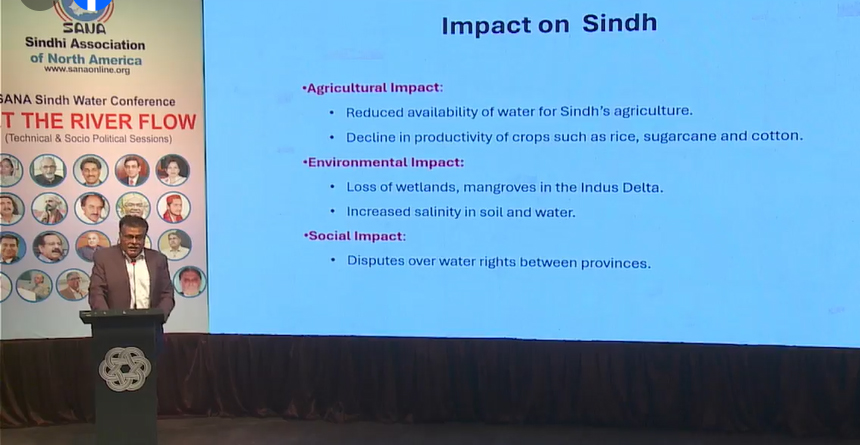We often focus on the Indus River as if the Chenab and Jhelum Rivers are of no consequence. In reality, all five rivers (Indus, Chenab, Jhelum, Ravi, and Sutlej) are interconnected. If these supplementary rivers are blocked or diverted, the Indus will ultimately be affected.
A known agriculturist and the Vice Chancellor of Sindh Agriculture University (SAU) Tandojan Sindh Dr. Altaf Sial says we often focus on the Indus River as if the Chenab and Jhelum Rivers are of no consequence. In reality, all five rivers (Indus, Chenab, Jhelum, Ravi, and Sutlej) are interconnected. If these supplementary rivers are blocked or diverted, the Indus will ultimately be affected.
Making a GIS Analysis of Proposed Strategic Canals in a program organized by diaspora Sindhis Association of North America (SANA) in Karachi, Dr. Sial said: We are raising objections to the construction of strategic canals, but many of us are unaware of their locations, where they start, or where they discharge. To help, I’ve compiled information about the geographic locations of these canals and will outline their potential impacts.
Some of these canals, like the Reni Canal and the Kachi Canal, were first excavated in 2001, but many of us have been unaware of their existence. Although they are not new, work is ongoing to extend them.
Currently, we have 19 barrages and a significant number of lined canals and watercourses. This extensive lining is contributing to the depletion of our fresh water aquifers in Sindh. Why wouldn’t our underground water resources decrease if everything is lined? The lining has effectively choked natural recharge systems, and this was done without fully assessing the environmental consequences. As a result, the river is drying, and the recharge of underground water resources has been halted, a situation that could worsen further.
Out of the six proposed strategic canals, the Jalalpur Canal stands out as a major concern. This canal, which is under construction, takes off from the Rasool Barrage on the Jhelum River, and will cost Rs. 32.72 billion. Satellite images already show its progression. The canal will carry 13,500 cusecs of water and will have a command area of 170,000 acres. As a perennial canal, it will draw water year-round, which could have significant consequences.
Next is the Greater Thal Canal. It is often confused with the Thal Canal, but they are two separate projects. The Thal Canal takes off from the Chashma-Link Canal, while the Greater Thal Canal is a seasonal canal, designed with several minor canals. It will carry 8,500 cusecs and irrigate lands in Khush, Layyah, Bhakar, and Jhang districts.
Link canals, such as the CJ and TP canals, were originally intended to supplement rivers that were allocated to India under the 1960 Indus Basin Treaty. These canals were supposed to operate only during the flood season. However, areas within the command areas of these link canals are now being irrigated throughout the year. Sindh has consistently objected to the early opening of the CJ Link Canal before the monsoon season. Sindh urgently needs water in April and May due to early sowing for the Kharif season. These canals should only be opened during the monsoon period. Currently, construction of the Chaubara Canal, which connects to the Greater Thal Canal, is underway after securing funding. This project will irrigate a total of 3.6 million acres.
The Kachi Canal, which takes off from the Taunsa Barrage, irrigates areas in DG Khan, Rajanpur (Punjab), Dera Bugti, Naseerabad, Bolan, and Jhal Magsi (Balochistan) over 175 kilometers.
The Reni Canal, although no official water allocation has been made, is still receiving water, and it will ultimately end in the Khairpur district. The Thar Canal is still on paper, with no detailed information available, though it is expected to reach Umerkot.
It is important to note that a large area upstream of the Reni Canal is affected by Punjab’s drainage water.
The Cholistan Canal, which will irrigate the Cholistan and Thal deserts of Punjab, will be 190 kilometers long, with a capacity of 4,000 cusecs. It is scheduled to start in 2024 and is considered a seasonal canal. The canal will take off from the Sutlej River, which does have water, but there is a risk of water being drawn from other rivers (including the Indus) through link canals. The Cholistan Canal will irrigate lands in Bahawalpur and Bahawalnagar.
We often focus on the Indus River as if the Chenab and Jhelum Rivers are of no consequence. In reality, all five rivers (Indus, Chenab, Jhelum, Ravi, and Sutlej) are interconnected. If these supplementary rivers are blocked or diverted, the Indus will ultimately be affected.
Consider the potential impacts on Kotri. These projects could have devastating agricultural, environmental, and social effects. Sindh is an arid region, with rainfall below 500 mm annually, and these changes could exacerbate the region’s water scarcity.
KARACHI: ER Report

